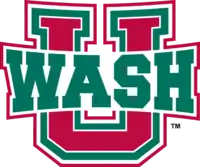School colors
School colors are the colors chosen by a school to represent it on uniforms and other items of identification. Most schools have two colors, which are usually chosen to avoid conflicts with other schools[1] with which the school competes in sports and other activities. The colors are often worn to build morale among the teachers and pupils, and as an expression of school spirit.[2]

School colors are typically found in pairs and rarely trios, though some professional teams use up to four colors in a set. The choice of colors usually follows the rule of tincture from heraldry, but exceptions to this rule are known.
Background

Common primary colors include orange, purple, blue, red, and green. These colors are either paired with a color representing a metal (often black, brown, gray (or silver), white, or gold), or occasionally each other, such as "orange/blue", "red/green", or "blue/yellow". Pairing two metals, such as "black/white", "silver/gold", and especially "black/gold", is also a common practice. Finally, some American schools, in a display of patriotism, adopt the national colors of "red, white, or blue."[3]
In an effort to further establish identity and promote a standard, many institutions often decree the use of specific shades of colors. Maroon, generally regarded as a darker shade of red, is a common primary color. Various shades of blue, from powder to Prussian, are also in use; a few schools have adopted two different shades of blue for their colors, with the darker shade serving as the primary. The shade of gold can vary greatly even within an institution, from a vivid yellow to a more convincing gold.
Black, white and gray are often used as neutral colors for sets that do not otherwise adopt them. This practice is especially notable in basketball (where home uniforms are often white) and professional baseball (where team colors are often used as trim for white or gray uniforms). School colors are typically found in pairs and rarely trios, though some professional teams use up to four colors in a set. The choice of colors usually follows the rule of tincture from heraldry, but exceptions to this rule are known.
Sports

Most competitive teams keep two sets of uniforms, with one emphasizing the primary color and the other emphasizing the secondary color. In some sports, such as American football, the primary color is emphasized on home uniforms, while uniforms for other sports, notably basketball, use the secondary or a neutral color at home. This is done to avoid confusing the two schools' colors.[4]
In addition, various groups that generate support for athletic teams, including cheerleaders and marching bands, wear uniforms with the colors of their school. At many private schools, or more traditional state schools, "school colors" are awards presented for achievement in a subject or a sport.
Academics

School colors have many non-athletic purposes as well. Members of a university's community will often display them as a sign of support or spirit for their particular institution. Likewise, during college or university ceremonies, those schools which award an academic hood to their students will generally abide by the American Council on Education guidelines and use the school colors on the inside and the disciplinary colors on the outside velvet trim (regardless of the ceremony, recipients of a degree have the right to wear the hood thereafter).
Some doctoral robes will also be in the colors of the university which granted the degree.
Academic Scarf

British and Irish universities traditionally have an academic scarf in the university's colors, usually long, woollen and patterned only with lengthwise stripes of varying widths. At collegiate universities such as Oxford, Cambridge, Durham and Lancaster, each college has its own colors and scarf. Other non-collegiate universities such as Glasgow and Newcastle have scarf colors for each faculty.[5]
References
- "Guide to the University of Chicago School Color History Collection 1894-1911". www.lib.uchicago.edu. Retrieved 2016-05-11.
- "Princeton University - Orange and black -- the history of Princeton's colors". www.princeton.edu. Retrieved 2016-05-11.
- "History of Penn Colors, University of Pennsylvania University Archives". www.archives.upenn.edu. Retrieved 2016-05-11.
- "Oxbridge Blue. How to win the varsity match". The Field. 2015-04-07. Retrieved 2019-06-11.
- "A brief history of academic scarves". Study.EU. Retrieved 2017-08-03.
External links
 Media related to School colors at Wikimedia Commons
Media related to School colors at Wikimedia Commons